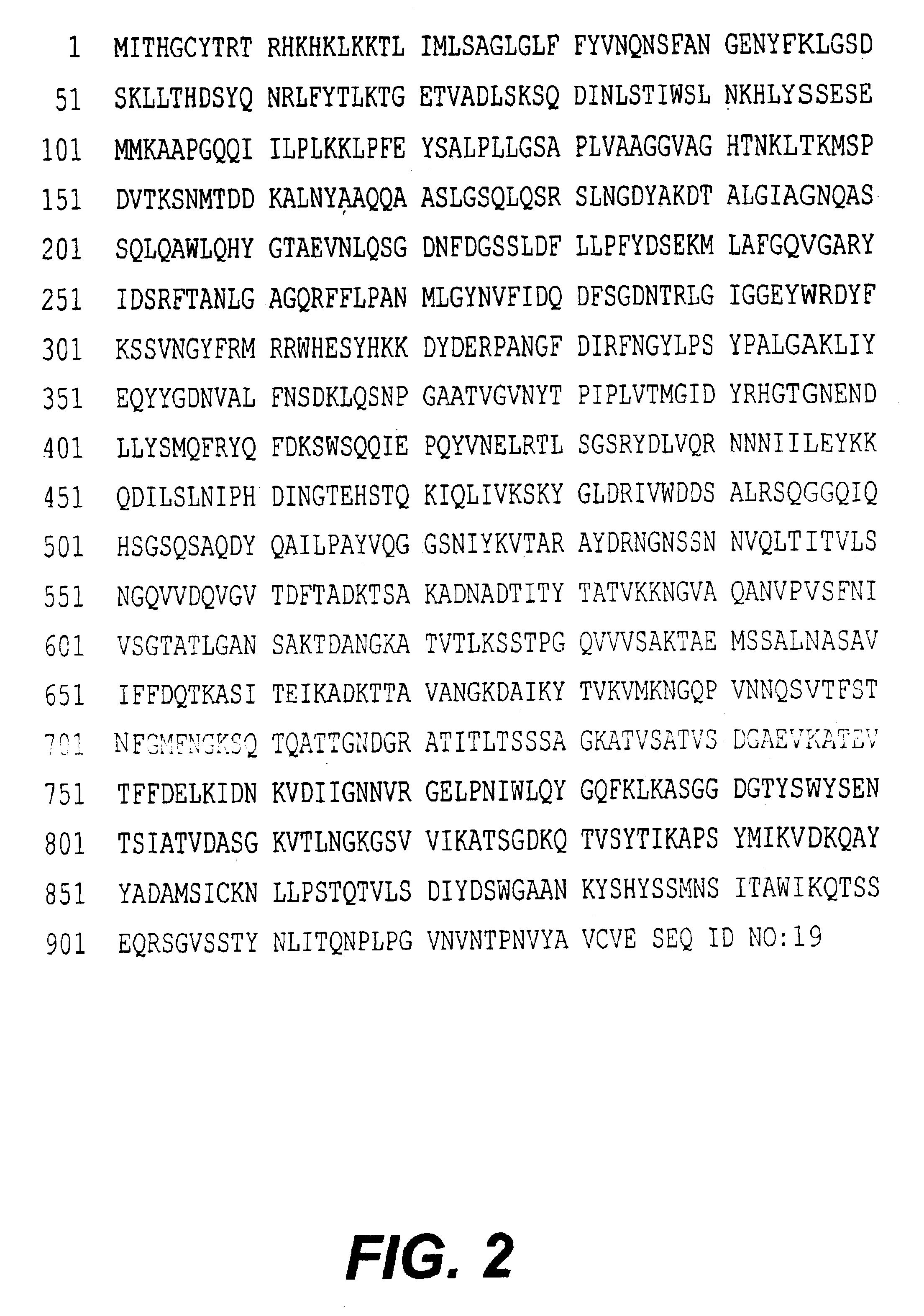Method of stimulating an immune response by administration of host organisms that express intimin alone or as a fusion protein with one or more other antigens
a technology of host organisms and immune responses, applied in the field of plasmids, can solve the problems of permanent kidney damage or even complete kidney failure, serious illness, and young children in particular are at greater risk of dying or suffering permanent damage from infection, and achieve enhanced adherence of 86-24, enhanced or complementing ehec binding, and the effect of restoring binding capability
- Summary
- Abstract
- Description
- Claims
- Application Information
AI Technical Summary
Benefits of technology
Problems solved by technology
Method used
Image
Examples
example i
D. Construction of Additional Plasmids Expressing Different Fragments of eae
[0086]Each of these plasmids is tested to ensure that the protein fragment possesses full binding function, using an adherence assay. (See example IV, below). In addition, the selection of the size of the intimin varies with whether the protein is expressed alone and whether cross-immunity is desired with an intimin-like protein of known amino acid sequence. In addition to intimin expressed from EHEC and EPEC, examples of intimin-like proteins include, but are not limited to, intimin-like proteins of Citrobacter rodentium, Hafina alveii, and the invasins of Yersinia enterocolitica and Yersinia pseudotuberculosis.
[0087]For instance, the larger 900 aa (amino acid) intimin is selected if there is heightened desire for cross-immunity with Yersinia pseudotuberculosis, because EHEC intimin shares 31% identical and 51% similar amino acids with the protein of Yersinia pseudotuberculosis, known as invasin (Yu, J. an...
example ii
Large Scale Enrichment of Histidine-tagged Intimin Growing Large-Scale Expression Cultures
[0112]Inoculate 20 ml LB (Luria-Bertaini) broth containing 100 μg / ml ampicillin and 40 μg / ml kanamycin with a loopful of M15 pREP4 pEB313 (prepared as described in Example I, above). Grow overnight (15-18 h) at 37° C., shaking vigorously. Inoculate 1L of LB broth containing 100 μg / ml ampicillin and 40 μg / ml kanamycin with 20 ml of the overnight culture. Grow culture at 37° C. with vigorous shaking until the OD600=0.7-0.9 (3 h). Add IPTG (isopropyl β-D-thiogalactopyranosidc, Sigma Chemical Co., P.O. Box 14508, St. Louis, Mo. 63178, 1-800-325-3010) to a final concentration of 1 mM (0.476 g) and continue to grow culture for another 3 h. Divide supernatant into 500 ml bottles (previously weighed) and centrifuge at 4000×g for 10 minutes. Discard the supernatant, weigh cell pellet, and store at −70° C., or process immediately.
[0113]Thaw cells for 15 minutes, vortex and resusupend in Buffer A [6 M GuH...
example iii
Purification of Enriched Histidine-Tagged Intimin
[0117]An enriched preparation of his-tagged intimin, generated as described in Example II above, is purified by techniques known to those skilled in the art, including, but not limited to, high performance liquid chromatography (HPLC), gel column chromatography, and SDS-PAGE.
[0118]With the SDS-PAGE method, an enriched preparation of his-tagged intimin is separated on a 10% polyacrylamide gel and visualized, for example, by staining an analytical lane with Colloidal Coomasie stain (Sigma, St. Louis, Mo.). The high molecular weight full-length intimin band can be excised from the preparative gel with a razor, and stored at 4° C. prior to immunization. Less than full-length fragments of intimin, i.e. portions of intimin, and / or intimin conjugated to one or more antigens can similarly be excised from the gel.
[0119]Regardless of the method used to purify intimin, or portion thereof, the purified protein as used herein refers to a populatio...
PUM
| Property | Measurement | Unit |
|---|---|---|
| concentration | aaaaa | aaaaa |
| molecular weight | aaaaa | aaaaa |
| molecular weights | aaaaa | aaaaa |
Abstract
Description
Claims
Application Information
 Login to View More
Login to View More - R&D
- Intellectual Property
- Life Sciences
- Materials
- Tech Scout
- Unparalleled Data Quality
- Higher Quality Content
- 60% Fewer Hallucinations
Browse by: Latest US Patents, China's latest patents, Technical Efficacy Thesaurus, Application Domain, Technology Topic, Popular Technical Reports.
© 2025 PatSnap. All rights reserved.Legal|Privacy policy|Modern Slavery Act Transparency Statement|Sitemap|About US| Contact US: help@patsnap.com



